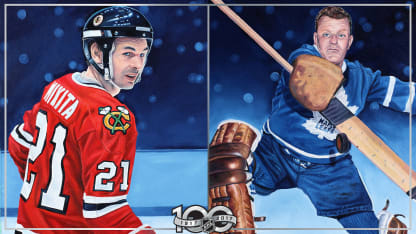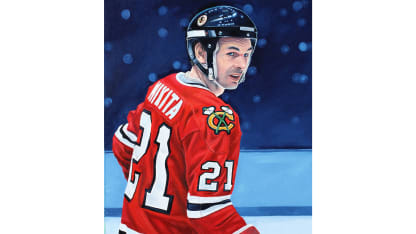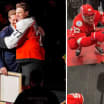Stan Mikita played 22 seasons in the NHL, all with the Chicago Blackhawks. He retired after the 1979-80 season and is Chicago's all-time leader in games played (1,394), points (1,467), regular-season assists (926), playoff assists (91) and playoff points (150).
The center is the only player to win the Hart, Art Ross and Lady Byng trophies in the same season -- and he did it in consecutive seasons, 1966-67 and 1967-68. He also won the Art Ross Trophy in 1963-64 and 1964-65. Mikita was named to the NHL First All-Star Team six times and the Second All-Star Team twice.
In his
NHL100 profile of Mikita
, author Bob Verdi details Mikita's improbable journey from Czechoslovakia to Chicago:
"In 1940, the 8-year-old who was born Stanislav Gvoth left his home in Sokolce, Czechoslovakia. Father Juraj was a maintenance man in a textile factory. Mother Emilia raised vegetables to feed the family. They adored their son, so much that they agreed to send him to Canada, where he could have a better life.
"Joe, Emilia's brother, and his wife lived there, having departed Czechoslovakia. They had no children, but they had freedom. Young Stanislav duly noted that, as well as amenities in their modest home: electricity, a refrigerator, space to spread out instead of sleeping four to a room.
"But his trip to Canada was not the short visit he thought it would be. He soon referred to Uncle Joe and Aunt Anna as his father and mother, and took their surname; Stanislav Gvoth became Stan Mikita. And as proof that truth is sometimes stranger than fiction, they resided in St. Catharines, Ontario, where a junior hockey team, the Teepees, would be sponsored by the Chicago Black Hawks.
"The rest really is history. After a three-game taste of the NHL in 1958-59, Mikita emerged as one of the greatest centers in League annals over 22 seasons, all with Chicago. In 2011, he and fellow icon Bobby Hull were honored with statues outside the United Center."
Artist Tony Harris said he hopes fans use their imagination when it comes to his portrait of Mikita.
"When painting an athlete's portrait you generally have two options: one, action and two, the moments between the whistles," Harris said. "Both can be effective in capturing a likeness but the shots like this one of Mikita let your imagination take over. Perhaps he is staring down an opposing goaltender or circling before taking a crucial last-minute faceoff."
In 14 seasons with the Toronto Maple Leafs, Turk Broda won 302 games, the most in NHL history when he retired in 1952. He had 62 shutouts and a goals-against average of 2.53 in his NHL career.
Broda won the Stanley Cup five times, including three in a row from 1947-49, the first time an NHL team accomplished that feat. He was in goal when the Maple Leafs staged their historic 1942 comeback to win the Cup, beating the Detroit Red Wings in seven games after trailing in the series 3-0.
Broda twice won the Vezina Trophy for fewest goals allowed in the League (1941, 1948), and he was named to the NHL First-Team All-Star twice ( and the Second All-Star Team once.
In his
NHL100 profile of Broda
, author Stu Hackel writes that he was not only a great goalie, but a favorite everywhere he went:
"But Broda was no Superman. He was more of an everyman. Only 5-foot-9 and of variable weight -- usually overweight -- Broda smiled often, parted his hair down the middle over his broad, cheery face and eschewed the position's more technical aspects in favor of reflexes and pure determination. He said he was 'just a guy who likes to play hockey.'
"And hockey fans everywhere liked Broda. He was so wildly popular that when the Montreal Canadiens arranged a 1947 postseason goodwill tour to promote their team in Western Canada through a series of games against a select group of NHL stars, it was Broda, not Canadiens stars such as Maurice Richard, Toe Blake or Elmer Lach, who was mobbed at each locale, upstaging his hosts.
"His Toronto teammates, who often played wide-open hockey and left him vulnerable, loved him as well.
"The media loved him, too, in part because unlike many other goaltenders, Broda was always good for a quote and loved to mug for the camera. He joked often, even when discussing his profession."
Harris said finding an image of Broda to use for his portrait was not an easy task.
"At one point the best option seemed to be the infamous picture of the Hall of Fame goaltender sitting in his crease with a stack of pancakes on his lap," Harris said. "Finally, with some help from the Maple Leafs, we found a promotional shot and after changing the sweater from white to blue it might be my favorite painting to date."




















